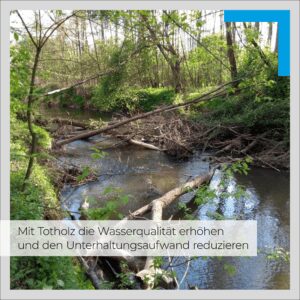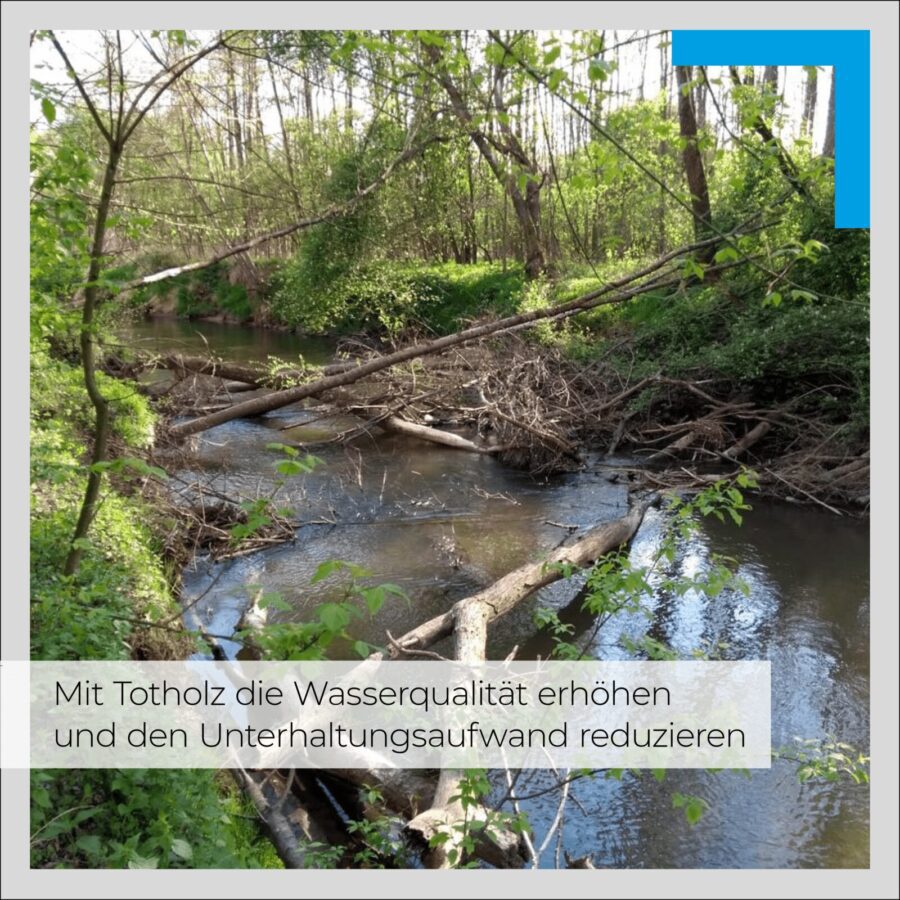

NEWS: Deadwood fulfils many important functions in flowing waters. It serves as a habitat and food base for a variety of organisms, it leads to a reduction in flow velocity and differentiation of the flow in the watercourse and thus to the formation of near-natural structures in and around the watercourse. Studies have shown that deadwood generally leads to an improvement in structural quality and ecological status, regardless of the type of watercourse.
Nevertheless, deadwood is still removed in many watercourses in the course of maintenance. The aim is to maintain the proper flow of the watercourse and to prevent damage to structures or adjacent areas. As a result, many watercourses have a low degree of naturalness and biodiversity. In addition, the organisms in the watercourse are disturbed by the maintenance measures.
If deadwood is deliberately introduced or left in watercourses, it can have many advantages. For example, the maintenance effort with regard to pruning and clearing the watercourse is reduced in the long term. At the same time, the quality of the water bodies is improved and near-natural development is promoted. However, the water bodies must be monitored more frequently, especially in autumn, to prevent undesirable developments from occurring. This is particularly important in areas where there is little space available for the watercourse or where structures need to be protected.
Due to the Water Framework Directive and the resulting increased requirements for the quality of running waters, a change is now taking place so that in many places more deadwood is being introduced into running waters or left in them.
When introducing deadwood, care should be taken to ensure that the material comes from the local area and, if this is not possible, that wood from species typical of the area is used. It is problematic that there are hardly any natural sources of deadwood left along most watercourses, so that material from outside the area has to be transported to the site. In addition, the elements should be fixed where space is limited in order to prevent undesirable developments. In order to protect constrictions in the watercourse and to reduce the maintenance effort, so-called deadwood rakes can be erected in the watercourse. These usually consist of posts that are inserted into the riverbed. The flotsam then collects at these points and can then be fixed or reintroduced below narrow points, for example.
In summary, it can be said that although deadwood must continue to be removed from watercourses in the course of watercourse maintenance, this should be limited to what is necessary. The wood should not be disposed of across the board, but reintroduced in a targeted manner elsewhere. This is a very cost-effective way to improve the quality of water bodies.
Do you have further questions on this topic or need advice on the professional implementation of watercourse restoration? Our competent "Flood Protection and Hydraulic Engineering" team from the "Water Management" department will be happy to advise you.
Engineering for a better tomorrow.
#deadwood, #environmentalprotection, 1TP5NaturalWaters, #EngineeringForABetterTomorrow

